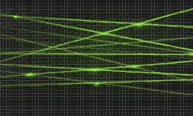Laser pointer protection is becoming an important issue. In many recent protests around the world, laser pointers have been used against law enforcement to distract or temporarily blind them. According to Senate testimony given on the Portland protests, 113 officers were temporarily blinded but all eventually recovered their sight.
Laser pointers are unlikely to cause permanent loss of sight at protests due to the intensity of the hand held lasers, the distance, beam spread and the difficulty of keeping the beam fixed on the target.
However, laser pointers can cause temporary blindness and distraction.
There are typically three types of hand held lasers used in protests, Violet lasers (405-445 nm), Green lasers (520-532nm) and Red lasers (630-670nm).
Before we go too deeply into potential solutions it is important to understand optical density. Optical density has an inverse logarithmic relationship to the amount of light transmitted at a frequency as shown by the following information:
| Optical density | Transmission (%) |
| 1 | 10% |
| 2 | 1% |
| 3 | 0.1% |
| 4 | 0.01% |
| 5 | 0.001% |
Many laser protective eye wear can have an optical density in the range of 3 to 5. Some military laser protective filter can even have an optical density of 7 or higher. This level of protection comes at both a high financial cost and performance issues which we will explain.
When trying to block a wavelength of a laser, you end up blocking not just the wavelength that you are concerned about, but also wavelengths adjacent to the laser. In some cases this band of wavelengths blocked can be reasonably wide. If you are just trying to block one type of laser, for example green, this can be manageable. However, if you try to block Violet, Green and Red lasers, you can inadvertently end up blocking a large part of the visual spectrum, making it difficult to see almost anything.
We have found examples on the internet of glasses blocking 99.9% of blue and green lasers (with no protection against red) and also blocking 51% of daylight and 81% of night light. Such large reductions in visibility will obviously affect the performance of the wearer.
The reason for this issue is that most laser protective eyewear has been adapted from technology used to give protection in the laboratory where the hazards are markedly different. Lasers are often high power and are fixed so focus the beam on a fixed point and the distances and beam spread are low. As a result, the hazard is high and a high optical density is needed to achieve protection.
In a law enforcement environment these laser point protection risk factors are all at the opposite end of the risk spectrum. The lasers are low power, hand held and used at longer distances with significant beam spread. These lower risk factors mean that there is an opportunity to modify the balance between the optical density at the laser wavelengths and the amount of visible light is able to pass through the protective eyewear.
On the basis that there have been no permanent injuries reported to have been caused by lasers to law enforcement, we are questioning the need to remove 99.9% or more of the laser wavelengths and having such a large negative effect on visibility.
It seems that there is an opportunity to block a lower percentage of laser wavelengths and still prevent distraction and temporary blindness while retaining good visibility. It may be that removing 99% (or even 90%) of laser wavelengths is more than sufficient to protect law enforcement during protests.
At HighLine we have access to technology that would allow customization of the polycarbonate sheet to achieve the perfect balance of protection and visibility for law enforcement. One advantage of this customization is that it could produce face masks, riot shields and even bullet resistant car windshields at a much lower cost than current options.
We believe that product customization can better match the laser pointer protection level to the threat level, while at the same time improving visibility and reducing costs.

